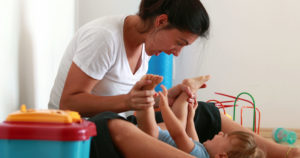Throughout our connecting activities series, the Nurture Science Program has provided a new perspective on what are frequently called “joint attention activities.”
How do we help our children (and ourselves) have a better—dare we even say fun—travel experience? By tapping into our biology.
Watching TV or a movie together can be a wonderful opportunity to co-regulate, especially for families! It’s something many of us already do on a regular basis, so why not get the most out of it that we can?
If we make chores activities of connection, we can turn the mundane into something meaningful, while protecting our children’s futures.
We hear a lot about why play is good for children’s brains, but something is going on inside children’s bodies when they’re in a playful state that has phenomenal impacts on their health. Playful interactions can also promote empathy, deepen their capacity to learn, and set them up for healthy future relating.
Humans are social beings, and our bodies really benefit from learning to fall asleep in the calming presence of someone who loves us.
When you approach bath time from a Nurture Science perspective, it can become a way to strengthen your emotional connection and improve your and your child’s health and mood.
A Nurture Science perspective on picky eating, dinnertime meltdowns, and how changing our approach to mealtime can have immediate and lasting benefits for the whole family.
In early childhood development, we hear so much about what’s measurable—how often children are read to, and how many words they hear by age three—that reading can feel more like a task to check off a list, than a special opportunity to connect.









